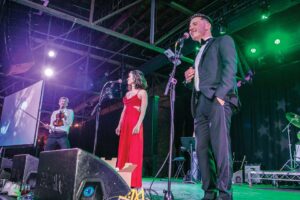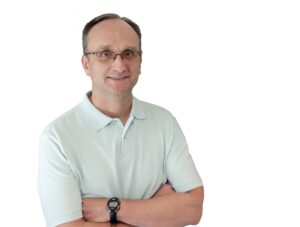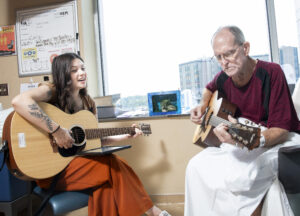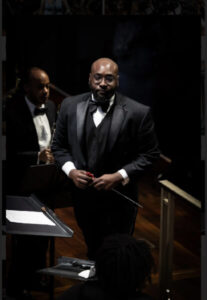Good Vibrations

For decades, Music Row and Vanderbilt University Medical Center, two Nashville institutions a short distance from one another, existed separately.
“There wasn’t a wall between them, but there weren’t strong bridges either,” said Roland “Ron” Eavey, MD, SM, emeritus faculty member, former chair of the Department of Otolaryngology-Head and Neck Surgery and former director of the Vanderbilt Bill Wilkerson Center.
Eavey’s predecessor, Robert Ossoff, DMD, MD, professor emeritus of Otolaryngology-Head and Neck Surgery and founder of the Department of Otolaryngology, made the connection between medicine and Music Row. Instead of treating patients in a one-off capacity, he created the Vanderbilt Voice Center in 1991 to focus on professional musicians and “preachers, teachers, lawyers” and anyone else with vocal issues.
“Instead of waiting until someone’s voice broke down and acting like a repair shop — just bring the car in the garage and we’ll fix it up — Dr. Ossoff knew that if we had a relationship with the [record] labels and the young talent, we could inform them how to best protect their voices so they didn’t have to break down and come into the garage,” Eavey said. “The Voice Center was created to keep Nashville singing.”
Like a mini-Country Music Hall of Fame and Museum, the walls of the Voice Center are lined with gold records of Music Row luminaries who are grateful for the care they’ve received, either before they had a vocal issue or afterward.
In 2009 Eavey took over where Ossoff left off and built another bridge between Vanderbilt and Music City, as Nashville is affectionately known. Together with Reyna Gordon, PhD, they established the Vanderbilt Music Cognition lab, a research hub located right on Music Row that connects neuroscience, psychology, genetics, education, audiology, speech-language pathology, engineering, music and medicine.
“I thought, well, people use their ears, noses and throats to communicate. Then I thought about it more deeply: If one person says ‘I love you’ to the other, they can create new humans. And if one person says ‘I hate you’ to the other, they can kill each other, and we remove humans from the planet,” Eavey said. “And this is a big jump, but in a way, the ear, nose and throat (ENT) structures we take care of are responsible for world peace. I wanted to study behavior changes in humans within the ENT purview, so I picked music. Where better to do this? We’re in Music City, and we’re Vanderbilt. It was too good to be true.”
The stories on the pages that follow — medical students, residents and researchers who use music to heal and entertain on
and off campus — are examples of how music and medicine exist in harmony
within Vanderbilt and out in the Music City community.
“Music isn’t just background wallpaper. There’s also a medicinal and emotional characteristic to it, and a chemical bonding that seems to exist between music and medicine and Vanderbilt,” Eavey said.
Take Note
VUSM alum in tune with Nashville Symphony Chorus

Though he sang in school and competitive choirs throughout middle and high school, and at Princeton University with the Glee Club, Chapel Choir and a traveling a cappella group, it took AJ Sermarini awhile to get back into music after he moved to Nashville to attend Vanderbilt University School of Medicine in 2019.
“I wanted to settle into the groove of lectures, anatomy lab and drinking from the proverbial fire hose as M1s do,” the tenor said.
Just when he felt ready to explore options in his new city, the COVID-19 pandemic pressed pause on all live music. Once the vaccine came out and masked music became an option again, a friend forwarded him an email about auditions for the Nashville Symphony Chorus (NSC).
“It was an immediate yes,” said Sermarini, who also sang in the medical school band Funk Bolus. “After more than two years of singing in the shower, I might finally get to sing in a group again — and for an audience other than my shampoo bottles,” he thought at the time.
With the NSC, Sermarini has live recorded two pieces, sung with world-renowned soloists and worked alongside the Nashville Children’s Chorus at the live Home Alone screening during the holidays. Since graduating from VUSM in 2023, he continues to sing with them as much as possible, though his schedule is less predictable now that he’s an anesthesiology intern.
“Singing with the Nashville Symphony Chorus throughout medical school and the beginning of residency has offered me a mental break from my studies and the stress of long, difficult days in the hospital,” said Sermarini, who’s from Boyertown, Pennsylvania. “For a few hours of rehearsal every week, I stop thinking about medicine and focus on the music. Almost nothing outside of the hospital allows me to fully disconnect in the same way.”
Though being a medical intern and singing require different skill sets, Sermarini sees some similarities: Both are team efforts that require him to listen to others and himself.
“Telling my vocal cords that the next note is a major fourth above the note I’m currently singing is really different than adjusting my needle on an ultrasound image when I’m performing a nerve block, but both require me to constantly listen to my surroundings and listen to myself,” he said. “Choir, and intern year, have been all about staying vigilant but also checking in on myself and taking note of areas I need to improve in. How did that movement in Handel’s ‘Messiah’ go for me? Was I rushing? Was I blending well with the altos? At work the next day, I ask myself, ‘How did that central line go? Was my ultrasound visualization good? Am I comfortable with the steps of the procedure?’”
Sermarini said singing has allowed him to connect with others in a way nothing else can.
“There is something so special about studying a piece of music on your own, learning your notes and rhythms, and coming together in a room of dozens of other people to make beautiful harmonies and something more beautiful than any of us could make individually,” he said. – Danny Bonvissuto
A symphony 20 years in the making

Rheumatologist Jim Gore, MD, sat near the stage at McAfee Concert Hall at Belmont University in May 2023 listening to the Tennessee Youth Symphony playing the wistful second movement of the “Kentucky 1862” symphony that pays homage to the rolling hills of Kentucky during the Civil War.
When the talented high school musicians completed the “Red Morn on Rolling Hills” movement, the audience enthusiastically applauded, the musicians rose to their feet, and the conductor, Anna Maria Miller, turned and gestured to Gore to stand.
Twenty years ago, Gore, who has had very little formal musical training, came up with the melody for the symphony. With the help of Blair School of Music Associate Dean for Faculty Affairs Michael Slayton, DMA, the music in his head became a reality in 2020.
A few years ago, Gore took online college-level music theory classes, and the instructor had other classes that he posted online — one of which was “write your own symphony, and I thought why not,” he said. Slowly a melody he had come up with 20 years earlier began to expand in his mind.
“The second movement had kind of softer pastoral sounds that made me think of the rolling hills in central Kentucky. I thought it would sound really nice if a flute started off playing the melody, then the orchestra came in behind it,” he said.
In 2019 he asked a friend who worked at Blair School of Music if she knew anyone who could teach him music composition. The friend put him in touch with Slayton, chairman of music composition at Blair. Gore told him he wanted to write a four-movement symphony in 19th century style. Slayton agreed to work with him in January 2020.
“I thought, I need to be prepared as this was my one chance to do this,” Gore said.
Slayton said he loved working with Gore.
“I normally wouldn’t take something on like that because I’m simply too busy. But when I saw the sheer amount of material Jim already had (in piano format, if I remember correctly), I was intrigued,” he said. “Here is a rheumatologist who has somehow found the time/energy to write almost 30 minutes of music. That spoke volumes on the front end.”
“Red Morn on Rolling Hills” was a Global Music Awards finalist in January 2022. Soon after his composition received the award, Gore mentioned it to Miller, the conductor of the Tennessee Youth Symphony.
“She said she thought it would be a great opportunity for the kids to play something where they could actually meet the composer,” he said. “It’s one thing to put notes into music composition software, but it’s another experience to see and hear performers bringing these ideas to life and the crowd enjoying it. It was surreal to hear a piece I put so much work into played by these teenagers who are really amazing musicians. I’m incredibly grateful.” – Nancy Humphrey
Field Work
It’s a familiar story: A musician comes to Nashville with considerable talent but no vocal training, and after a couple of years working the honky-tonks, his voice is shot. The goal of the Vanderbilt Voice Center is to reach musicians early, before they unknowingly do the kind of damage that requires surgery, but most musicians don’t slow down long enough for preventive care. K. Chuck Fletcher, MD, fellowship co-director of Laryngology and Care of the Professional Voice, understands the “show must go on” mentality, so instead of waiting for the show to come to him, he went to the show.
In September 2023, Fletcher set up a version of the Vanderbilt Voice Center in the backstage villages of the two-day, outdoor Pilgrimage Music & Cultural Festival in Franklin, Tennessee, in collaboration with Kevin Griffin, festival co-founder and Better Than Ezra front man. Accompanying Fletcher was a team that included a Voice Center physician colleague, speech pathologists and physical therapists from the Vanderbilt Dayani Center.
“Most of the problems the musicians we treat have aren’t to the point that they need medicine or surgery, but rather they need a lot of direction and maybe rehab, physical or voice therapy. That tends to be the crux of our focus,” Fletcher said. “If your throat is sore from singing, it’s probably your neck muscles, not your vocal cords. We were able to convey that to performing musicians between sets and provide techniques, strategies and hands-on physical therapy.”
Fletcher is already brainstorming ideas for Pilgrimage 2024, and hopes to use portable, disposable equipment to perform on-site endoscopies.
“Not only could we educate musicians, but we can look at them if they have a problem,” he said. “Once they see what we can do, musicians who’ve never been looked at are curious and want to learn more about their voices.”
Musicians weren’t the only ones who learned something at Pilgrimage: After a few conversations, Fletcher realized that being backstage, and not in a clinical setting, made musicians feel safer asking questions about topics like marijuana and how it affects the voice. Being there also gave Fletcher significant insight into a day in the life of a professional musician. – Danny Bonvissuto
Move to the Beat
Musical rhythms shown to improve language processing in children with developmental language disorder

Musical rhythms can help children with speech and language processing difficulties find their voices by improving their capacity to repeat sentences they just heard, according to an npj: Science of Learning study.
The study was conducted at the Lyon Neuroscience Research Center in France with 15 French-speaking children with developmental language disorder (DLD) and 18 typically developing French-speaking children without language processing difficulties between the ages of 5 and 13 years.
The children listened to music with regular and irregular rhythms for 30 seconds before being asked to repeat back sets of six sentences as accurately as they could.
Study authors, led by a Western Sydney University researcher and co-authored by Vanderbilt University Medical Center, found that the children — including those with language problems — were better at repeating the sentences out loud after they heard the regular musical rhythms, as compared to irregular musical rhythms.
“The study results are an exciting breakthrough that has shed new light on neurodevelopmental disorders, specifically for the advancement of DLD research and speech therapy practice,” said co-author Eniko Ladányi, PhD, adjunct assistant professor of Otolaryngology in the Vanderbilt Music Cognition Lab.
“Limitations in language processing in children with DLD can result in a struggle to understand their peers, teachers and parents. This can make it difficult to efficiently express their thoughts, which can lead to lifelong consequences in their academic and social lives,” she said.
Co-author and Vanderbilt Music Cognition Lab director Reyna Gordon, PhD, said effective speech-language therapy is essential to improving developmental outcomes for children.
“Our findings lay the groundwork for future clinical trials that could test a potential benefit of integrating rhythmic listening into traditional language therapy exercises,” Gordon said.
Researchers used regular rhythms that were at 120 beats per minute in 4/4 time, so the listener would feel the beat two times per second. Irregular rhythms were created by scrambling the regular rhythms so that it was not possible to extract a beat.
Study authors said that there was no difference in performance on a control task that did not involve language, suggesting that the benefit of the regular musical rhythm was specific to the language task itself.
“This finding that regular rhythms can boost sentence repetition is striking, considering that children with developmental language disorder have particular difficulty in repeating sentences out loud, especially when they are grammatically complex,” said co-lead author Anna Fiveash, PhD, a cognitive psychologist from Western Sydney University’s MARCS Institute for Brain, Behaviour and Development. – Craig Boerner
Vanderbilt Music Cognition Lab in National Spotlight
A decade ago, the National Institutes of Health (NIH) support for music-related biomedical research was sparse. That changed for the better in 2017, when the NIH, John F. Kennedy Center for the Performing Arts, and the National Endowment for the Arts formed a partnership called Sound Health and held a workshop to assess the state of research on how music impacts health and the brain.
Numerous new funding opportunities and awards followed, including a $2.9 million research grant award to Miriam Lense, PhD, co-director of the Vanderbilt Music Cognition Lab. Lense was an invited speaker at “Music as Medicine: The Science and Clinical Practice,” a prestigious two-day NIH Sound Health workshop held in December 2023. Lense’s presentation on the first day of the workshop highlighted exciting new findings from VUMC about how music and social development are intertwined in early childhood in typical development and in children on the autism spectrum.
“As a foundational component of early social experiences, music engagement provides a powerful medium for investigating social communication development and for designing meaningful and accessible interventions to support children and families,” she said.
Lense’s talk was part of a broader program summarizing key advances in scientific research on music and health over the past six years and establishing plans for the future. Lense’s grant and another new grant into musicality, hearing and genetics led by Srishti Nayak, PhD, research instructor of Otolaryngology-Head and Neck Surgery, were highlighted in invited remarks by the directors of the National Institute of Mental Health and National Institute on Deafness and Other Communication Disorders, respectively.
The second day featured sessions on future research, networks and integrating music-based interventions into clinical practice. Reyna Gordon, PhD, co-director of the Vanderbilt Music Cognition Lab, gave an invited talk about recent discoveries encompassing genomic influences on rhythm.
“The work that we are doing now at VUMC, and with our international Musicality Genomics Consortium, has opened up a new door to precision health,” Gordon said. – Danny Bonvissuto
Music’s Healing Power

Vanderbilt’s music therapy program focuses on the use of music to help with chronic pain, physical rehabilitation, psychiatric symptoms, end of life, procedural support and coping with hospitalization and disease.
Successfully applied to pediatric patients at Monroe Carell Jr. Children’s Hospital at Vanderbilt, the program recently expanded to include adult patients at Vanderbilt University Hospital.
The expansion is music to music therapist Tori Langham’s ears. Langham works with the adult patient population on the Palliative Care, Myelosuppression and Oncology units.
“Our goal is to improve the patient’s experience,” said Langham. “It’s been remarkable the impact our program is having. We are not just helping our patients, but staff as well. We all need support and to know what we are doing matters.”
Langham’s work often involves the management of anxiety, pain and relaxation using her music therapy interventions.
“We actually witnessed a patient using music therapy for a week and coming off of anxiety medications,” said Langham. “We were able to wean her.”
Music therapists use evidence-based research protocols to enhance clinical goals through music that is personalized to a patient’s clinical needs and goals. Sessions range between 15 minutes to two hours.
Music is a powerful force for healing, said Andy Wooldridge, MD, assistant professor of Medicine at Vanderbilt University Medical Center.
Wooldridge advocates for music therapy through his role as program director of Arts and Humanities in Healthcare for the Department of Medicine.
“Our overall vision is to enhance well-being on all levels at VUMC through the arts and humanities, and improving the patient experience with music therapy is a cornerstone of this broad initiative,” said Wooldridge. – Jessica Pasley
Leading with his love of music

Bruce Ayers’ musical journey began at age 4 with an old upright piano that sat in his grandparents’ home in Dover, Delaware, where he grew up. For someone on his way to becoming a composer and conductor, being drawn to piano at age 4 sounds about right.
In 2019, Ayers, a patient services specialist in the Neurology Clinic, conceived and founded the 70-member Nashville African American Wind Symphony, or NAAWS. Two years later Ayers took his bow at the conclusion of the first NAAWS concert, a Juneteenth 2021 performance at Belmont University in Nashville.
“The entire audience of about 450 people were on their feet,” he said.
The program included a piece Ayers had written for the band, “Journey,” depicting stations of his musical and personal development.
“It was my song, performed with the symphony that I had created — it makes me emotional talking about it right now. I don’t take it lightly that I’ve been blessed with a vision that has allowed me to play a part in changing people’s lives through my music.”
With a slate of concerts, and with Ayers as conductor, musical director and CEO, the band has garnered support from arts funders in Nashville and beyond. Ayers has been recognized by the Nashville Business Journal as among the city’s younger movers and shakers, appearing on their list of “40 Under 40” for 2024.
Ayers, 34, who joined Vanderbilt University Medical Center in 2020, also teaches music at Tennessee State University while completing a doctorate in organizational leadership at Trevecca Nazarene University. He already has a master’s in curriculum and instruction with a concentration in music from TSU.
By the time he finished his master’s program, Ayers had become sensitive to the issue of underrepresentation of Black people in classical music. Through college and grad school, he had taken part in classical music ensembles outside of school — symphonies, orchestras and recording sessions — where he happened to be the only Black person, or one of only a few.
“I knew I wanted to make a difference. That’s kind of how this organization got started,” he said. – Paul Govern
